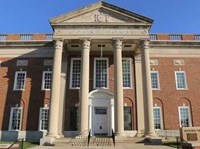The Oregon National Historic Trail Interactive Map
Here is a fun, exciting way to find places to visit. Zoom in to find a location. Click on the yellow balloon of your choice to see the site name, address, access, image, and website. You'll find museums, interpretive centers, and historic sites that provide information and interpretation for the Oregon National Historic Trail.
Please contact each site before you go to obtain current information on closures, changes in hours, and fees.
Error: You have supplied an invalid NPMap ID. Please edit this element data and check to ensure the id is correct.
Trail Sites to Visit in Missouri
Please contact each site before you go to obtain current information on closures, changes in hours, and fees.
Click on the site name or picture for more information about how to plan a visit.
Showing results 1-10 of 22
Loading results...
 Located just off of 3-Trails Crossing Memorial Highway in the heart of the historic 3-Trails Corridor, Trailside Center provides resources for trail and civil war aficionados, historians, and the Kansas City community. Few visitors realize that the communities that established in this area in the early 1830s were situated at the western edge of the United States until Kansas Territory was established in 1854.  This Barnes Enclosure and Cave Spring were made famous by overland travelers who mentioned it in their letters and diaries. Cave Spring, on the National Register of Historic Places, was a noted midday rest area for travelers heading west. Imagine that much of the Jackson County countryside, even in the early trail days, was owned by private landowners who had substantial estates.  Though not standing today, the mill once located at this intersection may have served traders involved in international commerce and travelers heading to or returning from the west. The filling station of the 19th century was the grist mill where needed commodities of flour and cornmeal could be procured and would sustain travelers over an 800-2,000 mile journey as they walked along the westward Santa Fe, Oregon and California trails.  Missouri’s famous painter and statesman, George Caleb Bingham, purchased the Lewis homestead and lived in this home during the Civil War where he painted, perhaps, his most famous masterpiece, “Martial Law,” or, “Order No. 11,” depicting the Union Army’s militarization of this area and depopulation of four counties along the Missouri-Kansas border in 1863. Trail ruts or swales are preserved on this site.  This 2,000-foot trail segment, located on the property of the Hickman Mills School District, begins just northeast of the district’s administration building (at 9000 Old Santa Fe Road, near Eastern Avenue).  The Santa Fe, Oregon, and California national historic trails (NHTs) passed through "New Santa Fe" in the Kansas City, Missouri area. Visit to see rare urban trail ruts and what’s left of a town created by trail traffic.  The historic trails passed through this area in the field that is directly across from the National Frontier Trails Museum. Evidence of the trails can still be seen in the field in the form of swales, which marks the exact route used by emigrants as they traveled westward. The museum is currently temporarily located at 416 W. Maple Ave., Independence, MO 64050.  Historic Truman Courthouse is the official start of the Oregon Trail, where wagons were outfitted through much of the emigration era. The original building on the site went up in 1836 in the Colonial Revival style.  Follow along the same path traveled by thousands of homesteaders, prospectors, and entrepreneurs. The Missouri River carried them to the Upper Independence landing two miles north of here. With their wagons loaded, they headed to town in Independence for final preparations. These the first miles of the overland journey to California, Oregon, and Santa Fe.  The Palestine Cemetery was an early burial ground for travelers along the Santa Fe, Oregon, and California trails.
|










